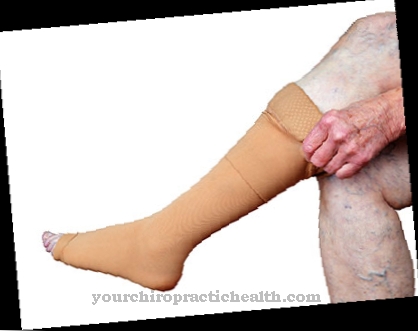The Willebrand-Juergens Syndrome is a congenital disease with an increased tendency to bleed. She often will too von Willebrand syndrome or short vWScalled and can be divided into different types. All belong to the group of hemorrhagic diatheses.
What is Willebrand-Juergens Syndrome?
The group of diseases was named after the Finnish doctor Erik Adolf von Willebrand and the German doctor Rudolf Juergens. Common feature of all forms of Willebrand-Juergens Syndrome is a quantitative or qualitative deviation of the so-called von Willebrand factor. The von Willebrand factor is often referred to as the coagulation factor because it plays an important role in blood clotting.
However, since it is not directly involved in the coagulation cascade, this title is technically incorrect. Rather, it belongs to the acute phase proteins. The deviations in the von Willebrand factor lead to blood clotting disorders and a pathologically increased tendency to bleeding. One also speaks of one hemorrhagic diathesis.
causes
The Willebrand-Jürgens syndrome is genetic. There are various mutations on chromosome 12 at the gene locus 12p13.3. There are also acquired forms, but these are extremely rare. They usually occur as a concomitant disease in heart valve defects, in the context of autoimmune diseases or in lymphatic diseases. The Willebrand-Jürgens syndrome can also develop as a side effect of medication.
Men and women are equally affected by the disease. However, the characteristics differ from case to case of illness. Type 1 of the syndrome has a quantitative deficiency, which means that too little von Willebrand factor is formed. About 60 to 80 percent of all cases of the disease belong to type 1.
About 20 percent of all patients suffer from type 2. Here the Willebrand factor is present in sufficient quantities, but it has defects. In type 2, five sub-forms can be distinguished. All subforms with the exception of type 2C are inherited as an autosomal dominant trait. The rarest but most serious form of the Willebrand-Jürgens syndrome is type 3. The blood does not contain any Willebrand factor at all. This form is inherited as an autosomal recessive trait.
Symptoms, ailments & signs
Many patients, especially Type 1 patients, have little to no symptoms and can lead normal lives. Some of those affected have a tendency to bleed for a long time from injuries or to bleeding after surgery. In addition, large-area hematomas can occur even with minor trauma. The menstrual period may be prolonged in female patients. One speaks here of a menorrhagia. If menstruation is also characterized by increased blood loss, it is referred to as hypermenorrhea.
The first signs of Willebrand-Jürgens syndrome are frequent bleeding from the nose or gums. In children, bleeding occurs during the change of teeth, which is difficult to stop. In severe forms, especially type 3, bleeding can occur in muscles and joints. Bleeding in the gastrointestinal area is also possible. In type 3 patients, these often occur in early childhood.
Diagnosis & course of disease
If the syndrome is suspected, standard blood clotting tests are performed. The blood count and Quick value (INR) are usually normal. The partial thromboplastin time (PTT) can be changed in severe cases. The PTT provides information on the functionality of the intrinsic blood coagulation system. The bleeding time is also determined, but in many cases, especially in type 1, it is without results. In type 2 it is occasionally, in type 3 it is actually always extended.
In all types, the factor VII-associated antigen, which is the von Willebrand factor, is always reduced. The vWF activity is also reduced. Type 3 and a sub-type of type 2 also have a reduced coagulation factor VIII value. With type 1 and the other sub-forms of type 2, this coagulation factor is normal.
In order to distinguish between the different types and sub-forms, both quantitative and quantitative studies of the Willebrand factor are carried out. Methods such as ELISA, electrophoresis or multimer analyzes are used for this. It is important to distinguish it from other hemorrhagic diatheses in terms of differential diagnosis.
Complications
In many cases, those affected with Willebrand-Jürgens syndrome do not suffer from any particular complaints and therefore no further complications. However, the syndrome can cause profuse bleeding in some people and, in general, a significantly increased tendency to bleed. As a result, even very light and simple injuries can lead to profuse bleeding and thus possibly to blood loss.
Constant nosebleeds can also occur. Especially in the event of injuries or after surgery, those affected are therefore dependent on taking medication to relieve this bleeding. In women, the Willebrand-Jürgens syndrome can lead to heavy and, above all, long menstrual periods. As a result, many women also suffer from mood swings and often from severe pain.
Many sufferers also have bleeding gums as a result of the syndrome and also bleeding in the stomach and intestines. The treatment of Willebrand-Jürgens syndrome can take place with the help of medication. There are no particular complications. Patients will always have to rely on medication in their lifetime in case bleeding occurs. If the disease is diagnosed and treated early, the life expectancy of those affected will not be reduced.
When should you go to the doctor?
If you notice abnormally heavy bleeding even after minor cuts or injuries to the body, you should consult a doctor. If the person concerned suffers from the development of bruises or skin discoloration, it is also necessary to clarify the cause. If left untreated, the loss of large amounts of blood can lead to a life-threatening condition. Therefore, a doctor should be visited as soon as the first abnormalities occur. If menstruation is associated with immense blood loss in sexually mature girls or women, a doctor should be consulted. If nosebleeds or bleeding of the gums occur frequently, it is advisable to discuss the observations with a doctor.
It can be a warning signal from the organism. If symptoms such as dizziness, numbness or a decrease in internal strength occur when blood is lost, the situation is worrying. In acute cases, a doctor must be consulted as soon as possible. In the event of a disturbance of consciousness or a loss of consciousness, an emergency service must be alerted. In addition, first aid measures must be carried out by those present. If, in addition to the physical irregularities, there are also emotional disorders, there is also a need for action. In the event of mood swings, pain, general malaise or internal weakness, the symptoms should be examined more closely by a doctor.
Therapy & Treatment
Long-term therapy is usually not necessary, especially for mild forms. Patients should avoid drugs containing acetylsalicylic acid, such as aspirin, as they can inhibit platelet function and increase hemorrhagic diathesis. Desmopressin is recommended before surgery or if there is increased nosebleed. Desmopressin stimulates the release of the von Willebrand factor. If the desmopressin has no effect, the administration of activated coagulation factors VII or VII may be indicated.
In the event of bleeding, careful bleeding must be stopped. A pressure bandage, for example, is suitable for this. In severe cases, especially in type 3, a blood coagulation factor preparation is administered for injuries and trauma. The Willebrand factor may also be substituted every two to five days. Children and adolescents with confirmed Willebrand-Jürgens syndrome should always have an emergency ID with them. This should contain the exact diagnosis including type, blood group and contact details for emergencies.
Patients with severe syndrome should avoid high-risk sports and ball sports with a high risk of injury. If the Willebrand-Jürgens syndrome is based on another disease, if the causal disease is cured, the syndrome will also be cured.
You can find your medication here
➔ Drugs for wound treatment and injuriesprevention
In most cases, Willebrand-Jürgens syndrome is inherited. Thus, the disease cannot be prevented. In order to prevent potentially life-threatening bleeding, a doctor should always be consulted for medical clarification the first time there is evidence of a hemorrhagic diathesis.
Aftercare
In the case of Willebrand-Jürgens syndrome, those affected generally have only very limited options for direct follow-up care. Since it is a congenital disease that usually cannot be completely cured, those affected should ideally consult a doctor at the first signs and symptoms of the disease and initiate treatment to prevent other complaints from occurring .
A genetic examination and advice is also very useful if you want to have children in order to prevent the syndrome from being passed on to your descendants. Most people affected by this disease are dependent on various surgical interventions, with which the symptoms and malformations can usually be alleviated. In any case, the person affected should rest and take it easy after the procedure.
Physical exertion or stressful activities should be avoided in order not to unnecessarily burden the body. Most people affected by this disease are dependent on the intake of various medications that can alleviate and limit the symptoms. The person concerned should always pay attention to regular intake and also to the prescribed dosage of the medication in order to alleviate and limit the symptoms.
You can do that yourself
In everyday life, care should be taken to keep the risk of an accident as low as possible. Since blood clotting is disturbed, special care must be taken with open wounds. Dangerous situations, sporting activities and physical activities are to be carried out in such a way that, if possible, no injuries occur.
It is also advisable to keep a note with the blood group and the diagnosed disease. A so-called emergency ID card should always be placed on the body or in a handbag, easily accessible. This can be life-saving in emergency situations, as people or emergency doctors can be informed immediately about the problem in the event of an accident and appropriate measures can be initiated. Furthermore, sufficient wound dressing should always be carried with you so that you can react immediately in the event of possible injuries.
Since the disease can be associated with mood swings or other behavioral abnormalities, psychotherapeutic support should be sought. This can be found helpful in coping with stressful situations or in phases of emotional stress. It is learned how the person affected can react appropriately in situations of emotional overload. In addition, he learns how he can at the same time enlighten his surroundings according to his feelings about the possible developments. It has been shown that sufferers in this area often have serious concerns.













.jpg)

.jpg)
.jpg)











.jpg)